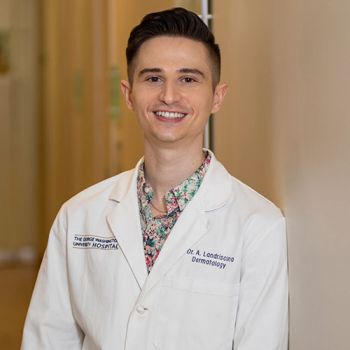
Close to the sandy beaches in Monterey, California, dermatology resident Angelo Landriscina, MD, of the George Washington University School of Medicine and Health Sciences (SMHS), presented research during a mentoring session as part of his role as a 2018 DermMentors Resident of Distinction.
Soon after, Landriscina learned that his presentation, “Silver Sulfadiazine Retards Wound Healing in Mice via Alterations in Cytokine Expression,” won the overall grand prize.
“I am so honored to win the overall grand prize as part of the 2018 DermMentors Resident of Distinction competition,” he said, “especially since this project was so important in shaping the way I approach medicine and science. Doing this work taught me the importance of challenging norms within our field, especially when the evidence shows that we could be doing better for our patients.”
During his presentation, Landriscina shared the results of a study he completed with colleagues, including Adam Friedman, MD, professor of dermatology and residency program director at SMHS.
For more than 50 years, the antibiotic silver sulfadiazine has been considered a gold standard treatment for burns. However, numerous studies have shown it does not hasten wound healing or prevent infection. The research group, Landriscina said, noticed that mice treated with silver sulfadiazine are almost always the last to achieve wound closure, and that even untreated controls heal faster.
So the team worked to understand the molecular and immunologic basis of the results and, in the end, found that treatment with silver sulfadiazine resulted in aberrant expression of an important cytokine family called interleukin (IL)-1. Early in the healing process, Landriscina said, burns go through an inflammatory phase where they expand compared to baseline. That is followed by a phase where the wound bed is cleared to make way for new tissue. A timely transition between the two phases is crucial for proper burn healing, and appropriate levels of IL-1 are needed for the process.
Landriscina and his team found that wounds treated with silver sulfadiazine expanded more in the first few days post-burn when compared to untreated controls. Histological and immunohistochemical analysis of the burns indicated that those treated with silver sulfadiazine were arrested in the inflammatory phase. Silver sulfadiazine treatment alters IL-1 gene expression leading to delayed transition to the next phase, allowing for greater burn expansion and, ultimately, delayed wound closure, the researchers found.
Landriscina was one of five dermatology residents across the country to earn the DermMentors Resident of Distinction Award, sponsored by Beiersdorf, a German personal care company, at the Coastal Dermatology Symposium held Oct. 3-6.
As an award recipient, Landriscina was invited to present his research at the conference. Award recipients also were assigned mentors and had the opportunity to learn from and interact with top thought leaders in dermatology.


